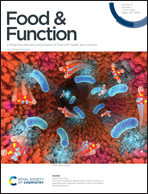Absorption and transport properties of a codfish-derived peptide and its protective effect on bone loss in ovariectomized mice†
Abstract
A potential osteogenic tetradecapeptide with the amino acid sequence GETNPADSKPGSIR (P-GM-2) was identified from Gadus morhua. The present study aimed to elucidate its absorption and transport properties using Caco-2/HT29-MTX co-culture monolayers and to evaluate its osteogenic activity using an ovariectomized mouse model. The results showed that P-GM-2 could cross Caco-2/HT29-MTX co-culture barriers intactly with an apparent permeability coefficient of 4.02 × 10−6 cm s−1via the TJ-mediated passive paracellular pathway. Pharmacokinetic results revealed that P-GM-2 was detectable in the blood of mice within 5 min of oral administration and reached its maximum concentration at 30 min. Furthermore, the oral administration of P-GM-2 for a duration of three months has been found to effectively regulate the secretion of key markers of bone turnover, thereby protecting against bone microstructure degeneration and bone loss in ovariectomized mice. Importantly, no toxicity related to the treatment was observed. Taken together, these findings offer valuable insights into the absorption and transport mechanisms of P-GM-2, highlighting its potential as a safe and effective active ingredient for preventing osteoporosis.



 Please wait while we load your content...
Please wait while we load your content...